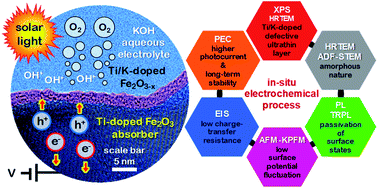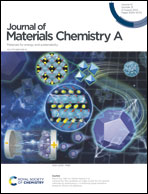An ultrathin amorphous defective co-doped hematite passivation layer derived via an in situ electrochemical method for durable photoelectrochemical water oxidation†
Abstract
Although hematite (i.e., α-Fe2O3) has been widely investigated in photoelectrochemical water oxidation studies due to its high theoretical photocurrent density, it still suffers from serious surface charge recombination and low photoelectrochemical stability. Here we report an in situ electrochemical method to form a uniform and ultrathin (i.e., 3–5 nm) passivation layer all over the pores of an optimized ∼3.2% Ti-doped α-Fe2O3 photoanode. We unveil the amorphous and defective nature of the in situ derived layer assigned to a high concentration of oxygen vacancies and intercalated potassium atoms there, i.e., the formation of Ti/K co-doped defective α-Fe2O3−x. Owing to the efficient passivation of surface states, alleviated surface-potential fluctuations, and low charge-transfer resistance at the interface, photoanodes show an average of ∼60% enhancement in the photoelectrochemical performance, applied bias absorbed photon-to-current efficiency of 0.43%, and faradaic efficiency of ∼88%. Moreover, the passivation layer prevents direct contact between the electrode material and electrolyte, resulting in less degradation and outstanding photoelectrochemical stability with a photocurrent retention of ∼95% after ∼100 hours, albeit by performing several successive in situ electrochemical passivation processes. This work presents an industrially scalable method to controllably engineer the interfaces of semiconductors–electrolytes with precious metal-free defective hematite-based co-catalysts for sustainable photoelectrochemical solar-to-fuel conversion applications.



 Please wait while we load your content...
Please wait while we load your content...